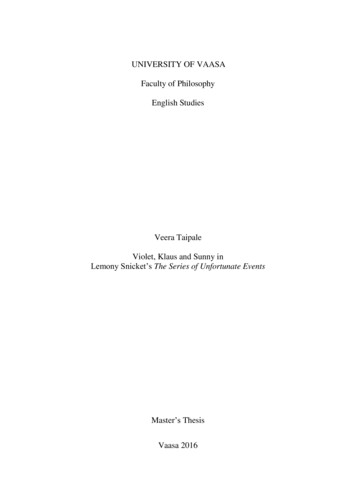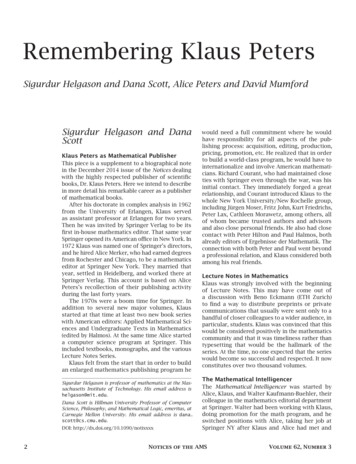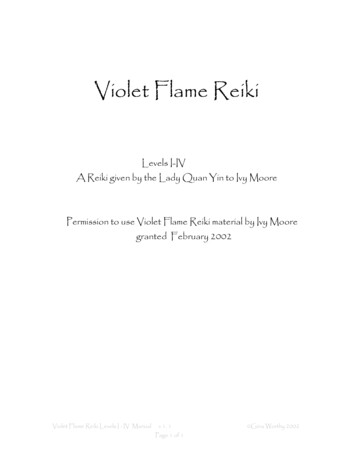
Transcription
UNIVERSITY OF VAASAFaculty of PhilosophyEnglish StudiesVeera TaipaleViolet, Klaus and Sunny inLemony Snicket’s The Series of Unfortunate EventsMaster’s ThesisVaasa 2016
1TABLE OF CONTENTSABSTRACT31 INTRODUCTION52 CHILDREN’S LITERATURE132.1 Characteristics of Children’s Literature142.2 Formula Stories162.3 Literary Orphans162.4 Fiction Series203 CHARACTERS IN CHILDREN’S LITERATURE223.1 Collective Characters223.2 Gender and Child Characters244 VIOLET, KLAUS AND SUNNY AND THEIR CONTRIBUTION TO THECOLLECTIVE CHARACTER324.1 Violet324.2 Klaus464.3 Sunny555 CONCLUSIONS616 WORKS CITED63
3UNIVERSITY OF VAASAFaculty of PhilosophyDiscipline:English StudiesAuthor:Veera TaipaleMaster’s Thesis:Violet, Klaus and Sunny in Lemony Snicket’s The Series ofUnfortunate Events.Degree:Master of ArtsDate:2016Supervisor:Tiina MäntymäkiABSTRACTTässä tutkimuksessa tarkastellaan Lemony Snicketin The Series of Unfortunate Events nimisen kirjasarjan kolmea päähenkilöä. Tutkimuksen päämääränä on selvittää,minkälaisia hahmoja Violet, Klaus ja Sunny Baudelaire ovat ja kuinka he muuttuvatsarjan edetessä. Lisäksi päähenkilöt muodostavat kollektiivisen hahmon, jatutkimuksessa tarkastellaan sen vuoksi myös sitä, millä tavoin päähenkilöt täydentävättoisiaan ja kuinka kollektiivinen hahmo muuttuu sitä mukaa, kun erilliset hahmotkehittyvät.Tässä tutkimuksessa on hyödynnetty Maria Nikolajevan teoriaa selvitettäessä mitälastenkirjallisuus on, mitä toistuvia teemoja siitä on löydettävissä, ja minkälaisia hahmojalastenkirjallisuudessa usein esiintyy. Erityisesti Nikolajevan teoria dessa usein esiintyviä kaavoja ja orpojen päähenkilöiden käyttöä MelanieKimballin teorian avulla.Tutkimuksessa selvisi, että kaikki kolme päähenkilöä ovat erilaisia, ja jokaisella heistä onomat vahvuutensa. Tarinan edetessä Violet, Klaus ja Sunny saavat lisää itsevarmuutta jaoppivat uskomaan omiin kykyihinsä. Koska päähenkilöt muuttuvat, niin myöskollektiivinen hahmo kokee muutoksen. Opittuaan tuntemaan omat vahvuutensa,päähenkilöt oppivat myös työskentelemään paremmin yhdessä ja luottamaan toisiinsa.KEYWORDS: Children’s literature, Orphan stories, Formula stories, Lemony Snicket
51 INTRODUCTIONLemony Snicket is the pen name of the American author Daniel Handler. Snicket’s mostwell-known work is the series of children’s novels which goes by the name The Series ofUnfortunate Events and consists of thirteen books. Lemony Snicket is also the name ofthe narrator of these stories and, in these stories, he explains that he has researched thelives of three children in the Baudelaire family and that he wants to tell the readers theirstory. The first part of this series, called The Series of Unfortunate Events: The BadBeginning, was published in 1999 and the last part, The Series of Unfortunate Events:The End, was released in 2006. Due to the popularity of the series it was turned into amovie in 2004 and a video game during the same year. Furthermore, the Americancompany Netflix is set to release a series based on Lemony Snicket’s books in the fall of2016, which suggests that The Series of Unfortunate Events has not lost any of its appeal.The aim of this study is to analyze the three main characters in The Series of UnfortunateEvents named Violet, Klaus and Sunny Baudelaire in order to discover what kind ofcharacters they are and how they change during the first three novels of the series. Inaddition, the Baudelaires form a collective character, and therefore I will also discuss howthese three children with their own unique traits and skills complete each other andcontribute to the collective character, and how the collective character changes during theseries.I chose to analyze these first three books of the series because Violet, Klaus and Sunnylose their parents and begin their life as orphans in the beginning of the series. I believethat the biggest struggle and growth of character can be found in these first books becausethe Baudelaire orphans are forced to recognize their own unique abilities and also believeand rely on their own and each other’s skills. The Series of Unfortunate Events can becalled a Bildungsroman because the three orphans grow as individual charactersthroughout the series, but they also begin to form a stronger bond with each other.I will analyze the characters of Violet, Klaus and Sunny by studying what they say, do,think and feel, and also by reviewing what the narrator tells about the protagonists and
6what other characters say about them and how they act towards Violet, Klaus and Sunny.I have gathered examples from my primary material of what the three main characterssay, do, think and feel, and what the narrator tells about them, and these examples formthe basis of the analysis. I have also chosen examples in which the three protagonistswork together in order to surmount the obstacles that they are faced with. Furthermore, Iwill compare the formula found in Snicket’s books to the formula that is often used inorphan stories. I will also compare Violet, Klaus and Sunny to traditional as well as tocontemporary boy and girl characters found in children’s literature.In the theory section of this thesis, I will first establish what can be considered ‘children’sliterature’ with the help of Maria Nikolajeva’s (1997) theory on children’s literature. Iwill then discuss different characteristics of children’s literature, including formulastories, orphan stories and series fiction. The usage of orphan characters is very commonin children’s literature, and some of the most memorable and beloved literary childcharacters are orphans, for instance J.K. Rowling’s Harry Potter or Pip from CharlesDickens’ Great Expectations (1861). According to Nikolajeva (1997:12), formula storiesare narratives that follow a recurrent pattern. Lemony Snicket’s series is a formula story,because a distinctive and reoccurring pattern can be found in every book. All three booksstart with Mr. Poe taking the three Baudelaires to a new home, and the children are scaredand worried about what obstacles they are going to face next. When they arrive to theirnew home, they soon discover that they are in danger. In the first book the Baudelairesrealize quickly that their new guardian is only after their fortune and that Count Olaf hasno intentions to provide Violet, Klaus and Sunny with a loving home. It soon becomesevident that Count Olaf has a plan to steal the Baudelaire fortune and because Mr. Poedoes not believe the children when they tell him that Count Olaf is only after their money,it is up to the children to stop Count Olaf. At the end of the book, the Baudelaires are ableto stop Count Olaf by using their wit. However, Count Olaf is able to escape.Orphan stories are a form of formula stories because they often follow a distinctive patternoriginating from folktales. Kimball (1999) has studied orphan stories and found a patternthat can be found in most tales with orphan protagonists. Orphan protagonists have alwaysbeen popular in literature and Kimball argues that this is because orphans represent the
7other; they are isolated from society, and without their parents they are forced to workharder than others in order to succeed. Moreover, orphan stories have traditionally ahappy ending, which gives the readers comfort; if the lonely orphan is able to persevere,it gives hope for others. I argue that the author’s choice to use orphan protagonists in TheSeries of Unfortunate Events is one of the reasons that the series has been so popular.However, the narrator keeps reminding that this particular story will not have a happyending: “So I must tell you that if you have opened this book in the hope of finding outthat the children lived happily ever after, you might as well shut it and read somethingelse” (RR: 3). The warning, or promise, that this story will be different from the storiesthe target audience might have been used to, will most likely peak the young reader’sinterest.I will also discuss the different types of characters found in children’s literature, includingcollective characters and girl and boy characters. According to Nikolajeva (2002), acollective character consists of multiple protagonists who are different actants, butbecause they share the same purpose in the story, they form one actor. A collectivecharacter is often constructed of siblings representing both genders and different agegroups and, for those reasons, the use of collective characters is an excellent way to appealto a wider audience.The 14-year-old Violet is the oldest of the Baudelaire orphans and acts as the leader oftheir small group. She is beautiful and smart and not afraid of getting her hands dirty.Violet is very clever, and her wits and inventive mind are usually the main reason for thesurvival of the orphans in the horrible events that they encounter throughout the series.Moreover, she is a very practical character and also an inventor. She is constantlyimagining new gadgets, and she is also interested in mechanics and finding out how thingswork. Her practical nature can, for instance, be seen when she ties up her hair becauseshe does not want her tresses to get in her way when she is trying to think. In addition,she also takes action and even gets hurt when she is trying to protect her younger siblings.As the oldest of the Baudelaire orphans, Violet feels responsible for the others. She is alsoa very kind and polite person, and she is very grateful during those few moments when
8someone shows the orphans kindness. She grieves every person that they are separatedfrom and even though the people they are forced to leave behind are not always the bestpeople imaginable, she remembers them fondly. Sometimes she even worries if sheremembered to be as good as she wanted to be towards those who treated her and hersiblings kindly. One of such instances can be seen when their guardian Dr. Montgomeryis murdered and Violet worries whether she thanked him for taking the children to themovies the night before, even though her own situation is becoming unbearable.The 12-year-old middle child Klaus is the only boy in this group of orphans. Similar toViolet, he is very smart and uses the power of his mind to deal with the unfortunate eventsthat the orphans encounter. He spends most of his time reading books, and he is able tohelp his siblings by seeking knowledge of whatever danger it is that the orphans are facedwith. Even though he is patient enough to seek knowledge from books, his forbearance israther short when it comes to dealing with adults who do not take their situation seriouslyenough or treat them like idiots, for instance by condescendingly explaining the childrenwords that they are already aware of.Sunny is the youngest of the Baudelaire orphans and, since she is only a baby, she doesnot yet speak fluently. Sunny communicates mostly through different kinds ofexclamations which her siblings understand and are usually translated to the reader by thenarrator. Despite her young age, Sunny is just as smart as her siblings. She seldom criesand is a rather more serious character who keeps a close eye on everything that is goingon. She is also usually the one who does most of the physical action since she is very fondof using the four sharp teeth that she has managed to grow so far.The primary material of this study consists of the first three novels of The Series ofUnfortunate Events, called The Bad Beginning (1999a; henceforth BB in references), TheReptile Room (1999b; henceforth RR in references) and The Wide Window (2000;henceforth WW in references). In the first book, The Bad Beginning, the three Baudelairechildren lose their parents in a horrible fire and are therefore left alone without anyone tolook after them. A close friend of the orphans’ deceased parents, a banker named Mr. Poe,takes on the responsibility of finding new guardians for the children and also manages the
9vast heritage that will be bestowed on the orphans when they become of age. Theorphaned children are handed over to a distant relative, Count Olaf. The Count turns outto be an evil and greedy character who tries his hardest to get his hands on the orphans’heritage. In order to get to the inheritance, Count Olaf decides to produce a play andforces the three siblings to appear in it. The play is called The Marvelous Marriage, andthe role of Count Olaf’s bride is given to Violet in this play.The Baudelaire children sense that Count Olaf has some evil plan in mind and, in orderto find out what that plan, is they seek help from Count Olaf’s neighbor, Judge Strauss.Strauss is a kind-hearted woman who is more than happy to let the three children use herlibrary. Klaus is able to sneak a law book from Strauss’ library and, after studying it, heis certain that Count Olaf’s plan is to actually marry Violet because he has asked JudgeStrauss to play the part of the Judge who marries the couple onstage. If Count Olafsucceeds in his plan to marry Violet, he will become fully in charge of the Baudelairefortune. Klaus confronts Count Olaf, but the Count is one step ahead: he has capturedSunny, and the youngest Baudelaire child is hanging from a small cage high up in thetower on Count Olaf’s yard. When Violet refuses to marry Count Olaf, he blackmails herto go through with the ceremony, or he will kill Sunny. Violet tries to save Sunny fromthe tower by building a grappling hook and climbing up the tower wall but, unfortunately,Count Olaf’s henchman is waiting for her at the top of the tower and the Count issuesViolet and Klaus a last warning: if they do not do as they are told he will kill Sunny.Violet and Klaus try to find a way to stop the play, but before they have time to come upwith a resolution, it is time for Violet’s character to perform in the play. Backstage, Klausattempts to convince Judge Strauss of Count Olaf’s intentions of marrying Violet in reallife and, once the marriage is binding, of stealing their money and most likely murderingKlaus and Sunny. However, Judge Strauss is far too excited and flattered to be given arole in the play and, as a result, she does not take Klaus seriously. Consequently, Violethas no other choice but to say “I do” and sign the marriage license, where after CountOlaf announces to the audience that his marriage with Violet is in fact legally binding andthat he is now in full charge of the Baudelaire fortune. The audience, including Mr. Poeand Judge Strauss, are appalled and cannot believe what has transpired. At this point,
10Klaus has given up hope but, surprisingly, Count Olaf gives his henchmen the order torelease Sunny. When Violet learns that Sunny is safe, she finally has the opportunity tospeak up. She states that according to the law, the marriage license has to be signed bythe bride’s “own hand” and that she signed the document with her left hand even thoughshe is right-handed. Judge Strauss declares that Violet is right and that the marriage is notlegally binding. When Mr. Poe and the others try to arrest Count Olaf, someone turns offthe lights in the theater, allowing Count Olaf and his assistants the chance to escape. Atthe end of the first book, the Baudelaires have saved themselves from Count Olaf, butthey are once again sitting at the back of Mr. Poe’s car, not knowing where he will takethem next.In the second book, The Reptile Room (1999), Mr. Poe takes the three Baudelaire childrento their distant relative, Uncle Montgomery Montgomery. To the children’s relief, theysoon discover that Uncle Monty is a loving and kind man who is eager to give the orphansa new home. Uncle Monty is a herpetologist, and he is planning to take a trip to Peru andwants the children to accompany him. Monty presents to the children the new snake breedthat he has discovered, the Deadly Viper. Despite the menacing name of the snake, thesnake is rather friendly and befriends Sunny as they both share a passion for biting things.However, matters start to go wrong when Monty announces that his former assistantGustav has suddenly quit his job and that he will be replaced by a fellow called Stephano.When Stephano arrives, the Baudelaire children immediately realize that Stephano isactually Count Olaf in disguise.Unfortunately, when the children try to warn Monty about Stephano’s real identity,Monty does not believe them and instead suspects that Stephano is a spy sent by theherpetological society to try to steal the newly discovered Deadly Viper. Monty and thechildren agree that they will leave for Peru without Stephano but, on the next day, thechildren find their Uncle Monty dead in his Reptile Room. Count Olaf forces the childrenwith him and plans to take them to Peru, where he imagines he will find a way to stealtheir inheritance. But as the party drives away from Monty’s house, they crash into Mr.Poe’s car. The children try to tell Mr. Poe that Stephano is actually Count Olaf, but Mr.Poe does not believe them since he suspects that the children are just shocked because of
11Uncle Monty’ s death. However, since Mr. Poe’s car is destroyed in the accident, thechildren, Olaf and Mr. Poe drive back to Monty’s house. Stephano states that he hascontacted a doctor to examine Uncle Monty’s body. The doctor subsequently declaresthat Monty’s death has been caused by a snake bite because he finds two pricks onMonty’s skin.Due to the fact that Mr. Poe refuses to listen to the children’s concerns, Violet decidesthat the children themselves must find evidence proving that Stephano is actually CountOlaf and that he has murdered Uncle Monty. As Mr. Poe and Stephano discuss how theywill transport both the children and Monty’s body away from the house, Violet, Klausand Sunny form a plan that aims to reveal Stephano’s true identity. In the end, the childrenare able to find evidence that proves that Stephano is Count Olaf and that he has murderedUncle Monty. Nevertheless, once again, Count Olaf and his assistant are able to escape,and the Baudelaire children are yet again homeless at the end of the book.The third book of the series, The Wide Window (2000), begins with Mr. Poe taking thechildren to stay with their new guardian, Aunt Josephine. Josephine lives by a large lakecalled Lake Lachrymose, and the children soon learn that their new guardian is terrifiedof the lake because her husband was eaten by the leeches living in the lake. AuntJosephine takes the children into town, where they meet a sea captain named Sham whois rather flirtatious with Josephine. The children recognize immediately that althoughCaptain Sham has a peg leg he is, in fact, Count Olaf again in disguise. Once more, theBaudelaires try to warn their new guardian about Count Olaf, but Josephine is too flatteredby Captain Sham’s flirting that she decides to ignore the children. After a phone call fromCaptain Sham, the children find a suicide note from Aunt Josephine and a broken windowfrom where she has jumped into the lake and into her death.The children are understandably devastated, and they decide to contact Mr. Poe. In hersuicide note, Josephine wishes for Captain Sham to take care of the orphans after herdeath, and Mr. Poe starts to arrange the adoption once again ignoring Violet, Klaus andSunny when they try to tell him that Sham is actually Count Olaf. However, the childrennotice that Aunt Josephine has left a coded message in her suicide note, which states that
12she is in fact not dead but that she has escaped to an island on Lake Lachrymose. She alsostates that it was Count Olaf who forced her to fake her death and give the guardianshipof the children to him. The children have no other choice but to go and find AuntJosephine or else they will once again be at Olaf’s mercy. The children succeed in findingJosephine, but they are attacked by the leeches as they sail back towards the shore. Whenthe party signals for help, it is unluckily Count Olaf who sails to their rescue. Olaf pushesJosephine into the lake, where she is devoured by the leeches. As Captain Sham bringsthe Baudelaires to shore and tries to act as the hero who saved the children, it is Sunnywho finds a way to prove Captain Sham’s true identity. Unfortunately andunsurprisingly Count Olaf and his assistants are once again able to escape, and thechildren are once more in the same situation: at the back of Mr. Poe’s car on their way toa new home.In the following chapter I will discuss children’s literature with the help of MariaNikolajeva’s theory. In addition, I will discuss the reoccurring themes and characteristicsfound in children’s literature.
132 CHILDREN’S LITERATUREWhile the term children’s literature is widely used, there has been some difficulties indetermining what children’s literature really is. Maria Nikolajeva (1997) states that, whilesome literary scholars use the term literary genre when discussing children’s literature,we cannot use the term genre because children’s literature does not have recurring orrecognizable features. She continues by stating that we can try to define what children’sliterature is by looking at what children actually read or by talking to the authors ofchildren’s literature, but not even by taking these matters into consideration are we ableto give a sufficient or simple answer to the question. However, in order to be able to studychildren’s literature, Nikolajeva uses a “working definition” according to which all thetexts that are targeted for children are considered to be children’s literature. (Nikolajeva1997: 8 9.) I will use the same definition as Nikolajeva, and according to this definition,The Series of Unfortunate Events can absolutely be categorized as children’s literaturesince it is targeted for children.According to Nikolajeva, children’s literature has traditionally been approached from apedagogical point of view. Literature has been seen as an excellent way of educatingchildren and, because of this, many studies on children’s literature have focused on whatwe consider appropriate or educational literature for children. Another approach tochildren’s literature has been to study it in relation to our society. This approach ispragmatic and studies how, for example, family life and school are portrayed in children’sliterature. However, Nikolajeva suggests that children’s literature can be studied from anaesthetic point of view and that children’s literature can simply be treated as literature.This approach allows us to study it using the same theories and methods that we use whenanalyzing any other types of literature. (Nikolajeva 1997: 7 8.) In this study, I willanalyze the material by taking into consideration all of these approaches because I arguethat the material has pedagogical, literal as well as aesthetic value. Moreover, the analysisof characters would prove nearly impossible if I chose to ignore the aesthetical approach.
142.1 Characteristics of Children’s LiteratureWhat are, then, the typical characteristics of children’s literature? To start with, I willdiscuss the archetypal plots that can be found in children’s fiction. According toNikolajeva (1997), conventional narrative plots present in children’s fiction originatefrom oral stories. The ‘master plot’ a recurrent element in the majority of children’sliterature entails the same pattern: home, departure from home, adventure andhomecoming. Nikolajeva elaborates by stating that the characters have to leave home inorder from something interesting to happen to them. Nevertheless, it is also dangerous tobe away from home, and that is why the characters always return to the safety of homeafter the adventure. (Nikolajeva 1997: 32.) The presence of this ‘master plot’ can also befound in my material. The series of unfortunate events that the Baudelaire children arefaced with would not occur if the children were not forced to leave their home.Another characteristic of children’s fiction is the notion of a happy ending. Most of thereaders expect a happy ending from stories that are targeted for children. MariaNikolajeva states that it is often the adults who expect a happy ending from a children’sbook and, to them, it is essentially seen as a necessity. This trait found in children’sliterature can also be traced back to oral stories and folktales. While happy endings arecommon in traditional children’s literature, Nikolajeva continues that modern children’sliterature has started to shift away from this tradition. As a replacement for a closedending where, for instance, the protagonist wins the battle against the antagonist, newopenings or apertures can be found in more recent books for children. When the authorleaves an open ending, it is left for the readers to decide what happens next and, in thisway, the author does not offer them a self-evidently happy or sad ending. Nikolajeva alsostates that apertures have become almost more common than closed endings, and thatsome scholars even consider apertures predictable and boring. (Nikolajeva 1997: 33 34.)Apertures can also be found in my material, and I argue that an open ending leaves roomfor imagination.An additional characteristic of children’s fiction are the recurring motifs. According toMaria Nikolajeva, the most typical motif is the ‘quest’. The quest for something can
15involve the search for an actual object or a person, but it can also refer to the quest offinding one’s own identity. Other common motifs in children’s fiction are the ‘journey’as well as ‘running away’, ‘pursuit’ and ‘escape’. ‘Survival’ is a motif that is recurrent ina so called ‘robinsonnade’, which originates from Robinson Crusoe. ‘The strugglebetween good and evil’ is most common in fantasy novels, but it can also be found indetective and adventure stories. ‘Mystery’ is a motif that is usually connected to criminalnovels, although murder is something that rarely occurs in children’s fiction, and themystery typically involves a crime such as smuggling. (Nikolajeva 1997: 35 36.) Mostof these motifs can be found in my material. The Baudelaire children are on a quest tofind a home and someone to care for them, while at the same time they are on a quest tofind their own identities. By discovering their own identities and their own skills, they areable to escape from Count Olaf and survive.‘Death’ as a motif has changed during the history of children’s literature. Death was acommon motif during the 19th century because it was present in everyday life. Thischanged after the Second World War when child mortality decreased and people’s lifeexpectancies increased. Because death became less present in the lives of children, itbecame an eschewed subject in children’s literature. However, according to Nikolajeva(1997: 36 38), there has once again been a change in the portrayal of death in modernchildren’s literature, and death has made an appearance in children’s literature for asecond time. Death is very much present in my material since the series begins with thedeath of the Baudelaire children’s parents. Moreover, Uncle Monty is murdered in thesecond book, and in the third book, the Baudelaire orphans are made to believe that theirAunt Josephine has committed suicide (and although she is later found alive, at the endof the book she is devoured by leeches).After roughly determining what can be considered children’s literature, how it can beapproached, and naming some of the most common characteristics, I will next discussone of the most frequent form of children’s literature: formula stories.
162.2 Formula storiesOne of the most common types of children’s literature is formula stories. MariaNikolajeva (1997: 12) describes the term ‘formula stories’ as follows: “Formula storiesare narratives that follow a recurrent pattern dictated by the mode: for instance, adventure,mystery, and romance.” These types of stories can also be found in mainstream literature.Crime fiction, for example, is a very good example of a literary genre that repeats thesame pattern.Formula stories have been criticized for their repetitiveness, but Nikolajeva states thatwhile some critics view formula stories and repetitiveness as a negative feature, empiricalstudies have shown that formula stories are favored by children of a certain age whenthey develop their skills as readers. Nikolajeva writes about “the joy of recognition” andthat children who enjoy reading adventure stories do not want to learn anything new butinstead enjoy the book as a form of entertainment. After having read formula stories, thechildren are familiar with the basic patterns found in literature and, henceforth, it is easierfor the young readers to develop their skills further and start reading more complexstories. Nikolajeva continues by stating that formula stories should not only be viewed asa useful form of “training exercise” but, instead, they should be recognized as having avalue of their own. (Nikolajeva 1997: 12.) This is a very plausible argument, and alsovery true: we should not judge one genre as good or bad as compared to other genres. Iwill discuss formula stories in more detail in subchapter 3.1 and explain how formulastories and collective characters are connected to each other.2.3 Literary orphansOrphan stories are formulaic fiction, and I will discuss the pattern found in most storiescontaining an orphan protagonist with the help of Melanie A. Kimball’s article “FromFolktale to Fiction: Orphan Characters in Children’s Literature” (1999). According toKimball, the use of orphan characters is very common in fiction aimed at children, andthat these orphan characters originate from folktales. Orphan protagonists are popular
17because they represent the other; they are isolated from the rest of society because theydo not belong anywhere, and they do not have a family or a home. Even though orphansare, in many ways, sad characters because of their loneliness and isolation, they al
story. The first part of this series, called The Series of Unfortunate Events: The Bad Beginning, was published in 1999 and the last part, The Series of Unfortunate Events: The End, was released in 2006. Due to the popularity of the series it was turned into a movie in 2004 and a video game during the same year. Furthermore, the American










